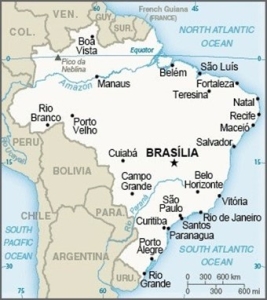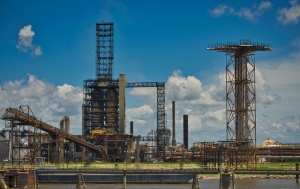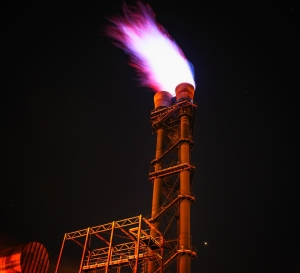The Changing Energy Market in Brazil.
Continuing our series reviewing other countries in the Western Hemisphere, Twin Feathers looks at the country of Brazil. In this two-part post, we examine this country’s resources and explore their connection to the global LPG markets.
 Population and Location.
Population and Location.
Brazil is the largest and easternmost country in South America. It is the world’s fifth-largest country by area and the seventh most populous. Its capital is Brasília, and its most populous city is São Paulo. It is the only country in the Americas to have Portuguese as an official language. Due to over a century of mass immigration from around the world, it is a multicultural and ethnically diverse nation.
Bounded by the Atlantic Ocean on the east, Brazil has a coastline of 7,491 kilometers (4,655 mi). Bordering all other countries and territories in South America except Ecuador and Chile, it covers roughly half the continent’s land area.
Environmental Resources.
Brazil’s Amazon basin includes a vast tropical forest, home to diverse wildlife, a variety of ecological systems, and extensive natural resources spanning numerous protected habitats. This unique environmental heritage is the focus of significant global interest, as environmental degradation through processes like deforestation has direct impacts on global issues like climate change and biodiversity loss.
Oil Production and Reserves.
World’s 8th Largest Oil Producer.
 Brazil is the world’s 8th-largest oil producer. Until 1997, the government owned Petroleo Brasileiro S.A. (Petrobras) had a monopoly on oil. However by 2006, more than 50 different oil companies were engaged in oil exploration. The only global oil producer is Petrobas, with an output in 2023 of more than 3.4 million barrels of oil equivalent per day, and natural gas production of 157.99 MM cubic meter per day. Currently Brazil is the largest oil producer in South America and has the largest recoverable ultra-deep oil reserves in the world. It is also a major distributor of oil products and owns oil refineries and oil tankers.
Brazil is the world’s 8th-largest oil producer. Until 1997, the government owned Petroleo Brasileiro S.A. (Petrobras) had a monopoly on oil. However by 2006, more than 50 different oil companies were engaged in oil exploration. The only global oil producer is Petrobas, with an output in 2023 of more than 3.4 million barrels of oil equivalent per day, and natural gas production of 157.99 MM cubic meter per day. Currently Brazil is the largest oil producer in South America and has the largest recoverable ultra-deep oil reserves in the world. It is also a major distributor of oil products and owns oil refineries and oil tankers.
2nd Largest Proven Oil Reserves in South America.
Brazil had a proven crude oil and natural gas liquids (NGL) reserves of approximately 9,311.6 million barrels in 2023. This is the second-largest proven oil reserves in South America after Venezuela. Most proven reserves were in the Campos and Santos offshore basins off the southeast coast of Brazil. In November 2007, Petrobras announced that it believed the offshore Tupi oil field had between 5 and 8 billion barrels of recoverable light oil and neighboring fields may even contain more, which all in all could result in Brazil becoming one of the largest oil producers in the world.
Natural Gas Reserves and Production.
Significant Natural Gas Reserves.
 Brazil’s proven gas reserves stood at 9,854.4 billion cubic feet in 2023. Potential reserves are expected to be 2 times higher than those figures. Until recently natural gas was produced as a by-product of the oil industry. Petrobras controls over 90 percent of Brazil’s natural gas reserves.
Brazil’s proven gas reserves stood at 9,854.4 billion cubic feet in 2023. Potential reserves are expected to be 2 times higher than those figures. Until recently natural gas was produced as a by-product of the oil industry. Petrobras controls over 90 percent of Brazil’s natural gas reserves.
Production Does not Meet Demand.
In 2022 the average daily natural gas production was 138 million cubic meters, reflecting a 2.98% increase from the previous year, which is less than the natural gas consumption of Brazil. Gas imports come mainly from Bolivia’s Rio Grande basin through the Bolivia-Brazil gas pipeline (Gasbol pipeline), from Argentina through the Transportadora de Gas de Mercosur pipeline (Paraná-Uruguayan pipeline), and from LPG imports. For more than a decade, Brazil has consistently imported LPG gas from the United States, maintaining significant volumes that have exceeded 25 MM bbls per year.
Brazil’s Changing Energy Market.
Brazil is the world’s 8th largest oil producer, with the 2nd largest proven oil reserves in South America. It has significant natural gas reserves and established infrastructure for production and transportation of LPG products. However, Brazil does not produce enough natural gas to meet the country’s demand and requires substantial volumes of LPG imports each year.
Additionally, Brazil is home to one of the world’s largest environmental treasures in the Amazon Basin. This is why the country is extremely interested in alternative energy sources that could have a less harmful impact on the environment.
These factors, along with growing developments in neighboring countries, as well as across the globe, are causing a shift in Brazil’s energy market. This change could also impact the global propane markets and is why Twin Feathers is watching these shifts with interest. Check back in the coming weeks for our Brazil Part 2 post. We will take a closer look at Brazil’s natural gas production levels and what impact that could have on the global markets.
“Your trusted advisors for energy markets.”



